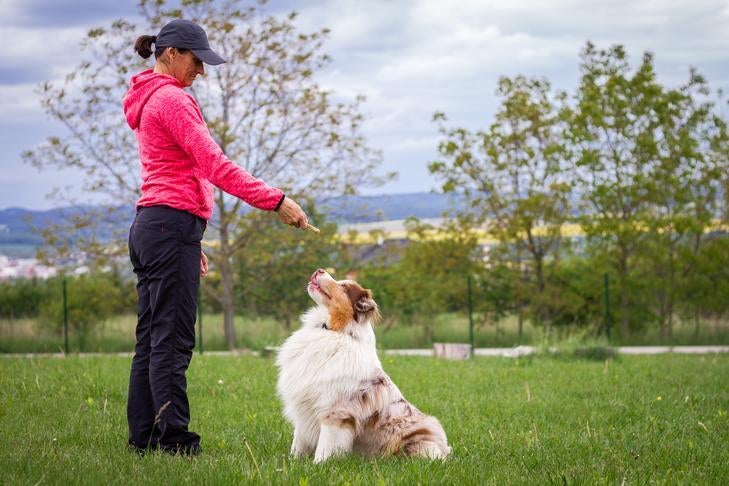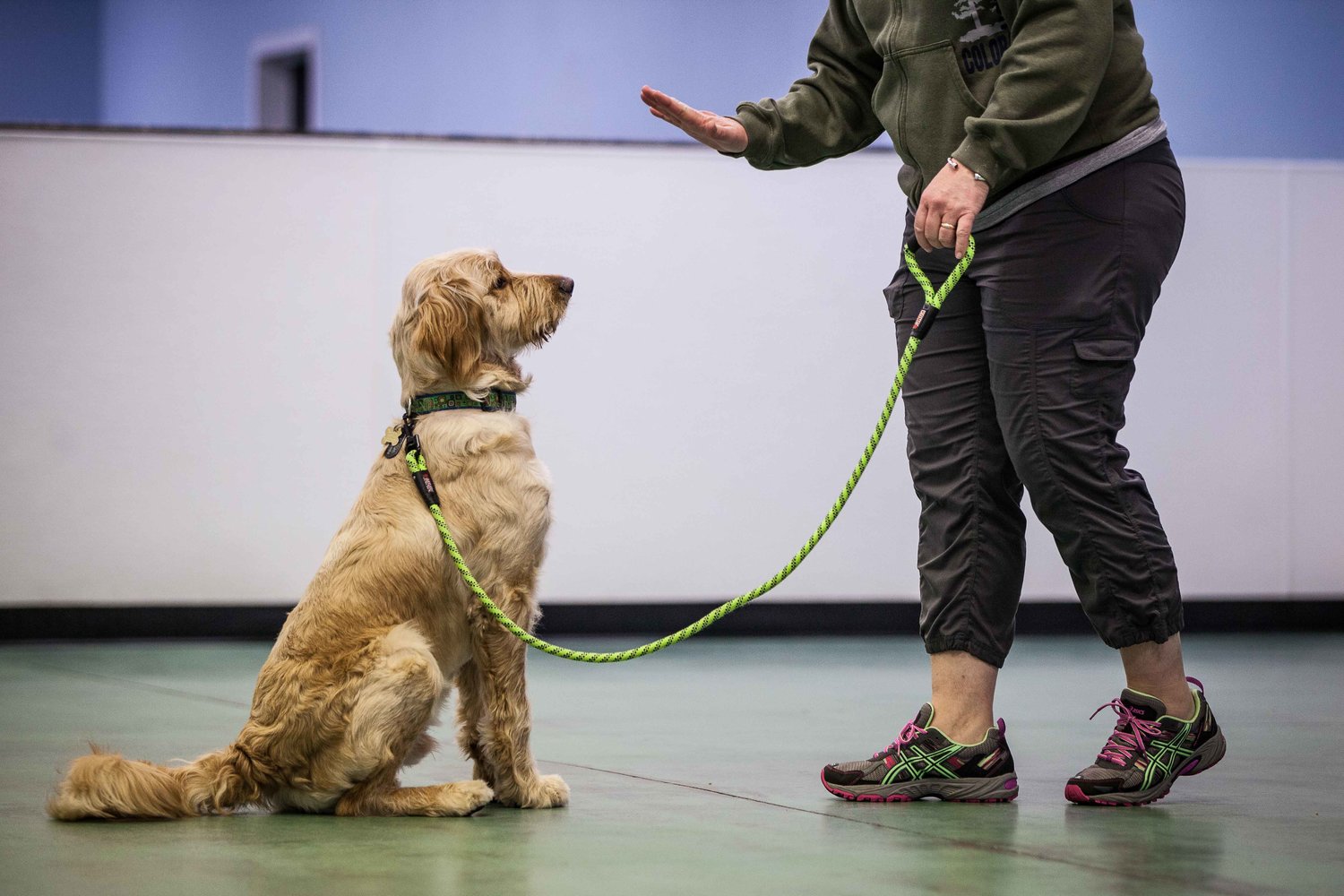Dog Training for First-Time Pet Owners: What You Need to Know
Dog Training for First-Time Pet Owners: What You Need to Know
Blog Article
Leading Pet Dog Educating Methods Every Proprietor Must Know

Favorable Reinforcement Techniques
Utilizing favorable reinforcement techniques is important for effective pet training, as it cultivates a trusting bond between the instructor and the pet. This method concentrates on fulfilling preferable behaviors as opposed to penalizing unfavorable ones, creating an environment helpful to discovering. Rewards can consist of treats, appreciation, or play, which motivate pets to duplicate the behaviors that gain them these benefits.
:strip_icc()/young-woman-training-her-dog-686725227-588bab6d5f9b5874ee8bcef5.jpg)
In addition, this strategy enhances the pet's enthusiasm for training sessions. When pets associate training with positive experiences, they are a lot more involved and responsive. Past prompt behavior adjustment, favorable support encourages a collective connection in between the dog and trainer, lowering anxiety and fear
To take full advantage of performance, it is essential to provide incentives promptly, guaranteeing the pet attaches the behavior with the reinforcement. Basically, positive reinforcement methods not just generate better-trained pets yet additionally promote an unified partnership between pet and proprietor.
Clicker Training Technique
The clicker training method is a very effective technique that builds on the concepts of positive reinforcement by including a distinctive sound to mark preferred actions. This technique uses a small handheld tool that generates a clicking noise, enabling trainers to interact with their dogs in a immediate and clear fashion. When a canine does a habits that the owner desires to encourage, the remote control is turned on, complied with by a benefit, normally in the kind of deals with or appreciation.
The key to successful remote control training hinges on uniformity and timing. It is essential to click at the exact minute the preferred habits occurs, guaranteeing that the dog links the noise with the action and the subsequent incentive. This technique not only enhances interaction however also cultivates a more powerful bond between the pet and the proprietor, as it urges involvement and communication during training sessions.
Clicker training can be related to a range of commands and habits, from basic obedience to more complex tricks. Its flexibility and performance make it a preferred method among expert fitness instructors and pet proprietors alike, leading the way for a well-trained and receptive canine companion.
Leash Training Basics
Effective leash training is vital for making certain a delightful and safe strolling experience for both dogs and their proprietors. A level collar may work for some pets, while others might benefit from a harness that decreases drawing.
Present your canine to the leash gradually, permitting them to explore it in a comfortable atmosphere. Technique loose-leash walking useful reference once they are accustomed. This involves gratifying your pet dog for strolling close to you instead than drawing in advance. Use treats and praise to reinforce preferred habits, and make sure to stay assertive and calm.
If your dog begins to draw, quit strolling immediately. Additionally, practice various walking settings to help your canine adjust to disturbances.
Normal method will strengthen your canine's understanding of leash etiquette. Bear in mind that leash training is a recurring procedure; perseverance and consistency will generate the finest results, cultivating a positive experience for both you and your canine companion.
Socializing Methods
Socialization is an important aspect of pet training that ought to preferably begin during puppyhood however can be helpful at any age. Reliable socialization aids canines develop self-confidence and reduces the chance of behavioral issues. To apply successful socializing techniques, reveal your pet dog to a variety of settings, people, and various other animals.
Beginning with controlled setups, such as puppy courses or organized playgroups, where young dogs can connect securely. Gradually present your pet to new experiences, including different noises, surfaces, and tasks. Ensure these experiences are fulfilling and positive to establish a complacency.
For grown-up pets or visite site those lacking exposure, start with low-stress scenarios. Short, positive communications with pleasant people and tranquil dogs can produce favorable organizations. Utilize treats and appreciation to enhance preferable behaviors during these experiences.

Uniformity and Perseverance
Identifying the value of consistency and patience in dog training is essential for attaining enduring results. Training a pet is a progressive process that requires a structured strategy and unwavering dedication from the owner. Each command or actions need to be strengthened regularly to aid the pet dog comprehend what is anticipated of them. Irregular training can result in confusion, making it challenging for the dog to realize commands or habits, eventually hindering progression.
Pet dogs, like human beings, find out at their very own speed. This cultivates a relying on connection in between the pet dog and proprietor, motivating a much more ready and passionate learner.
To cultivate consistency and persistence, establish a routine training regular, utilize the exact same commands, and guarantee that all relative apply the same training concepts - Dog training. By doing so, you develop a steady atmosphere favorable to discovering, enabling your dog to thrive and develop right into a mannerly companion
Conclusion
In conclusion, reliable pet dog training methods, such as positive support, clicker training, and proper chain training, are essential for cultivating a healthy and balanced owner-dog connection. Additionally, applying socializing techniques and keeping uniformity and persistence throughout the training procedure adds considerably to a pet's general well-being. By incorporating these techniques, dog proprietors can help with the growth of well-adjusted, loyal pets, inevitably enhancing the top quality of life for both the owner and the pet.
Among the most noticeable techniques are positive reinforcement, clicker training, and chain training, each offering distinct advantages that contribute to a mannerly dog. As we check out these basic approaches, it comes to be obvious that grasping their nuances can dramatically affect the training experience and the dog's general behavior.Making use of positive support methods is important for effective pet dog training, as it cultivates a trusting bond between the pet dog and the instructor.In conclusion, efficient pet training techniques, such as positive reinforcement, remote control training, and correct leash training, are vital for cultivating a healthy and balanced owner-dog relationship. By integrating these techniques, pet owners can help with the advancement of well-adjusted, loyal pet dogs, ultimately improving the top quality of life for both the owner and the pet dog.
Report this page